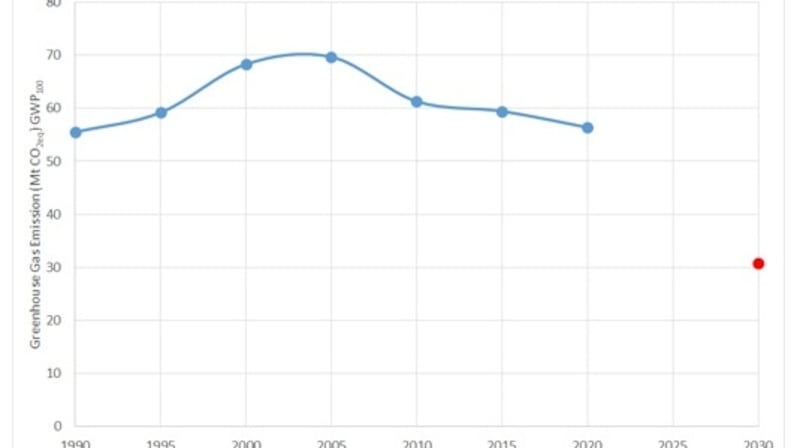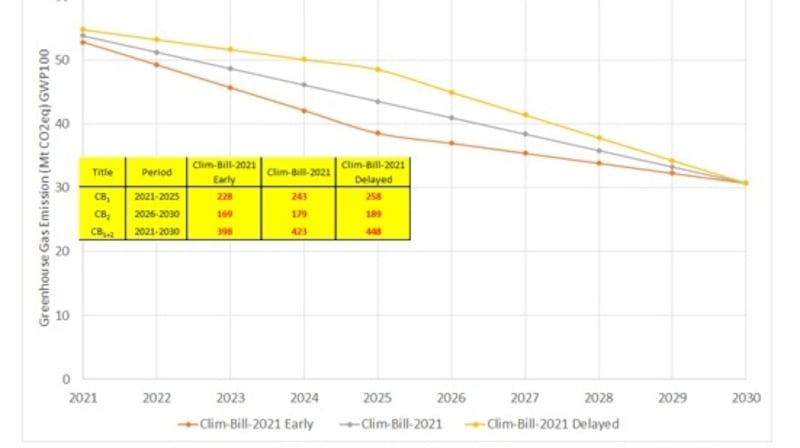The recently published Climate Bill 2021 commits Ireland to pursue and achieve the transition to a climate neutral economy, by no later than the end of the year 2050. It further introduces a process for establishing five-yearly carbon budgets that will be proposed by the Climate Change Advisory Council (CCAC), finalised by the Minister for Climate and approved by the Government.
Here the term carbon budget is used to define the total amount of greenhouse gas (GHG) emissions that Ireland is permitted to emit during each five year period. Carbon budgets can be a useful way of providing short-term goals aligned with Ireland’s long-term target. The CCAC is tasked initially with proposing the first three carbon budgets, ie covering the periods 2021-2025, 2026-2030 and 2031-2035. This initial analysis focuses on Ireland’s first two carbon budgets, covering the period 2021-2030.
There are many considerations that need to be taken into account when determining what the carbon budgets should be. Among these are Ireland’s ambitions for emissions reduction in the period covered by the budgets. It makes sense to also consider Ireland’s legal obligations under EU effort sharing agreements on emissions reductions and Ireland’s obligations as a signatory of the international Paris Agreement on climate action.
National target and carbon budgets 2021-2030
The revised Climate Bill 2021 states the first two carbon budgets “shall provide for a reduction of 51 per cent in the total amount of greenhouse gas emissions over the course of the first two budget periods ending on December 31st, 2030, from the annual greenhouse gas emissions reported in 2018”.

This provides a clear target for emissions reduction to be achieved by 2030, ie Ireland’s GHG emissions should be reduced to at most 31 million tonnes of carbon dioxide equivalent. Figure 1 compares this short-term ambition to Ireland’s historical emissions provides an indication of the scale of the challenge over the next 10 years.
While the 2030 target does provide us with a goal by a particular year, it does not tell us how many emissions Ireland can emit in the 10-year period to 2030. One option is to consider a simple straight line pathway between 2020 and 2030, as illustrated in Figure 2. It is the combination of the end point and the pathway that provide the framework to calculate the carbon budgets. In this case, the total carbon budget over the 10 years is 423 million tonnes of carbon dioxide equivalent, split into 243 million tonnes in the first five-year period and 179 million tonnes in the second five-year period.

Early action or delayed action?
Another option is to consider increased early action, or indeed delayed action. Delayed action might be justified because of the limited time available to develop and implement ambitious policy pathways in the first five years, particularly since that first period has already commenced.
Early action might be justified if the national ambition is not aligned with obligations under EU law, or not aligned with the Paris Agreement. Ireland’s 2030 obligations for emissions reduction under EU law are likely to be determined by the end of this year. The EU has agreed to increase its target for GHG emissions by 2030 (from 40 per cent) to 55 per cent below 1990 levels.
Converting this overall EU-wide ambition into an effort sharing agreement among Member States is currently underway. Early MaREI Centre estimates suggest that if there is not a significant change in process Ireland’s 2030 obligations will likely be aligned with the carbon budgets shown in Figure 2.
Alignment with the Paris Agreement is a more complex question. Climate modelling studies have established a robust near-linear relationship between global warming and cumulative carbon dioxide emissions since industrialisation. This enables calculation of a global carbon budget, ie the future (or remaining) cumulative CO2 emissions consistent with a given warming limit.
The UN IPCC (Intergovernmental Panel on Climate Change) concluded the global carbon budget is likely to be 420 billion tonnes of CO2, but due to uncertainties could be up to 1,340 billion tonnes. This would ensure (within a 67 per cent probability) that global warming does not exceed 1.5 degrees above pre-industrial levels.
Translating this global carbon budget into national carbon budgets is a complex process, both from an analytical and a political perspective. The global carbon budget covers carbon dioxide only. Ireland’s first two national carbon budgets will cover all GHG emissions (in particular include methane and nitrous oxide emissions). A number of methods have been developed that provide options for how the global budget can be distributed but there has not been political consensus on this. It is therefore unclear at this point to what extent the carbon budgets quantified here are aligned with the Paris Agreement.
Figure 3 highlights the effect that early action and delayed action can have on carbon budgets. It is interesting to note that all of these pathways reach the 51 per cent emissions reduction 2030 target, but result in cumulative greenhouse gas emissions that vary by 50 million tonnes (which is equivalent to Ireland’s total annual emissions by 2024, if one of these pathways is followed).

Are these carbon budgets achievable?
What is presented here is indicative of some of the boundary conditions surrounding the development of carbon budgets. The purpose is to share some of the considerations that may influence the carbon budgets that the CCAC will ultimately propose.
What is not covered here is the achievability of these carbon budgets. There are many dimensions to the question of achievability but two important ones are the sectoral allocation of carbon budgets and the implications of the Covid-19 pandemic.
Distributing a five-yearly total carbon budget among the different sectors will likely be a challenging and contentious process. How much emissions reduction between now and 2025 is anticipated to come from agriculture? From industry? From households? Analysis is under way to explore how different sectors can reduce emissions, which of course is a key factor in whether sectors can achieve the required levels of emissions reductions.
Our responses to the Covid-19 pandemic have shown us that we can do things differently. We can introduce policies that were deemed impossible pre-Covid. We have also shown that we can listen to the science and respond accordingly if we accept there is an emergency.
Finally we can collectively make significant changes in how our institutions work, how we respond, how we support and how we achieve in ways that we may not have imagined just over a year ago. We have redefined the notion of what is achievable.
Brian Ó Gallachóir is director of MaREI, the SFI research centre for energy, climate and marine research, and professor of energy engineering at University College Cork







